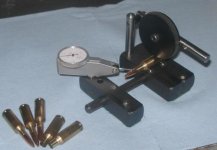I have some experience with using concentriciy gauges that are designed to straighten loaded ammo, and while I absolutely agree that these tools are best used to diagnose issues that are the primary cause of ammo runout, under certain conditions , straightening may work out, while in others it probably will not.
For thin necked cases with neck tension much less than factory ammo, and particularly when they are loaded with flat base bullets, that have significant pressure rings at their bases, one can do a limited amount of straightening. I have, in the past, done so, for an entire weekend benchrest match. To give a little more weight to this, I will mention that I believe that I have heard that no less a shooter than Lester Bruno has done the same, with a tool that he sells (has sold?)
A few years back, I was at a match at Visalia, and spoke with one of the better shooters that would come up from Southern California (I believe) and among other things, he showed me a small hand held tool that was made from hardwood, that was fitted with a test best type of indicator, with which he quickly checked, and if needed, straightened each loaded round. He had a habit of taking home wood, and was a force to be reckoned with in any match he entered.
Over a decade ago, when I was testing a very well made tool that Ron Hoehn sold, I tried to straighten some factory .220 Swift ammo, and found that it was probably not a good idea. In that test, I shot the same ammo, both as it came, and straightened, and could tell no difference on the target.
On the other hand, for my PPC, with a little practice, it was easy to make small corrections, without apparent damage to case necks.
I should add that none of this will save you from a missed condition, or being out of tune...but it may make you feel better if you prefer tinkering to studying conditions.

